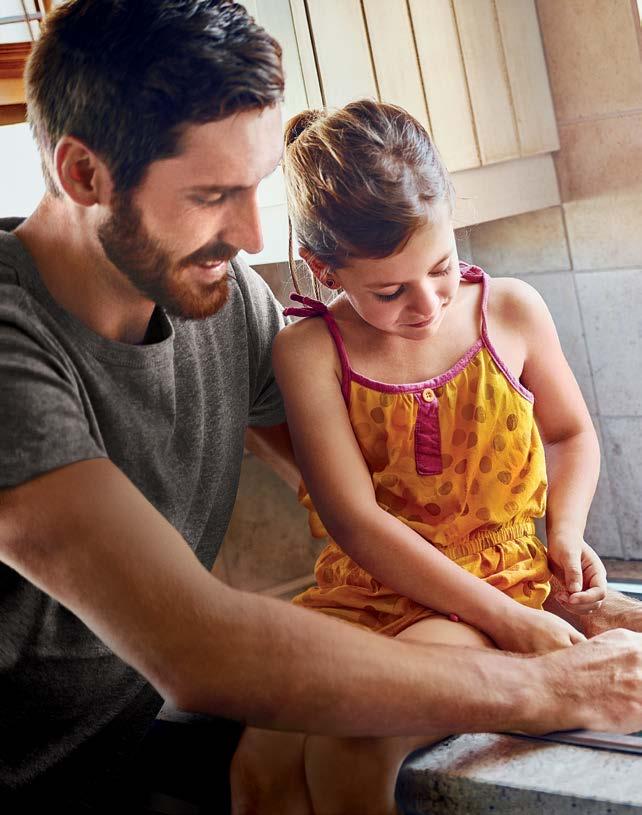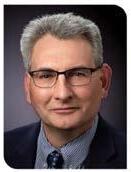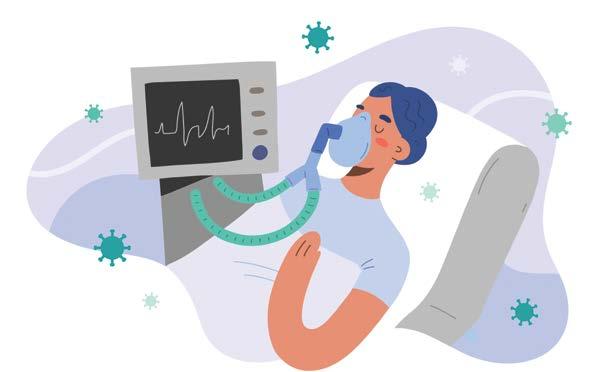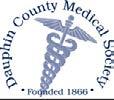
















































SPRING 2023 Your Community Resource For What’s Happening In Healthcare Official Publication of the Dauphin County Medical Society PLUS Ventilators & Ventilation made ridiculously easy PAGE 10 for the New Year
IT COULD MAKE ALL THE DIFFERENCE TO HER.
IDENTIFYING RISK FACTORS FOR HEART DISEASE EARLY CAN SAVE YOUR LIFE.
Blood pressure. Cholesterol. Glucose. Weight. And family history. These are just a few of the things doctors use to identify risk factors for heart disease, the leading cause of death in the country for both men and women. February is American Heart Month. Don’t put off getting your heart checked — in-person or through virtual visits — to know your risk factors. Learn more at UPMC.com/CheckYourHeart.

CHECK YOUR HEART.
2023 DCMS BOARD OF DIRECTORS
Joseph Answine, MD President
Andrew Lutzkanin, III, MD Vice President
Everett C. Hills, MD
Secretary/Treasurer
Shyam Sabat, MD
Immediate Past President
MEMBERS-AT-LARGE
Michael D. Bosak, MD
Robert A. Ettlinger, MD
John Forney, MD
John D. Goldman, MD
Virginia E. Hall, MD, FACOG, FACP
Saketram Komanduri, MD
John C. Mantione, MD


Mukul Parikh, MD
Gwendolyn Poles, DO
Andrew J. Richards, MD, FACS, FASCRS
Jaan Sidorov, MD
Andrew R. Walker, MD
William Wenner, Jr., MD
Paul Williams, DO
EDITORIAL BOARD

Joseph F. Answine, MD, Editor in Chief
Kaela N. Luchs, Association Executive/ County Coordinator
Robert A. Ettlinger, MD
Gloria Hwang, MD
Puneet Jairath, MD






Mukul L. Parikh, MD
Meghan Robbins
Shyam Sabat, MD
MEDICAL STUDENTS/ RESIDENTS/PENN STATE AMA REPRESENTATIVES
David Brinton
Madison Hearn President
Kirsten Mansfield
Alyson Rich






Emily Schuchardt, DO
Madeline Matzelle-Zywicki Vice President
Contents
The opinions expressed in this publication are for general information only and are not intended to provide specific legal, medical or other advice or recommendations for any individuals. The placement of editorial opinions and paid advertising does not imply endorsement by the Dauphin County Medical Society. All rights reserved. No portion of this publication may be reproduced electronically or in print without the expressed written consent of the editor.
Exercise for for the New Year
2022 Scott A. Gunder, MD, DCMS Presidential Scholarship Essay 10 Ventilators & Ventilation Made Ridiculously Easy 14 Assistant Physician Resolution: Follow-Up From The 2022 HOD Central PA Dauphin County Medical Society 400 Winding Creek Blvd. • Mechanicsburg, PA 17050 (833) 770-1541 • dauphincms.org Central PA Medicine is published by Hoffmann Publishing Group, Inc. Reading, PA | HoffmannPublishing.com | (610) 685.0914 SEE PAST ISSUES AT CPM.HoffmannPublishing.com SPREAD THE WORD #PACentralMedMag FO R ADVERTISING INFO CONTACT: Sherry Bolinger, Sherry@hoffpubs.com, 717.979.2858 RECEIVE THE LATEST UPDATES BY FOLLOWING US ON SOCIAL MEDIA SPRING 2023 Editor's Message 4 Legislative Updates 16 Restaurant Review 18 DCMS News 20 In Every Issue
Features 6
8
ABBOTT AND COSTELLO’S OPINION ON MEDICAL CLEARANCE FOR SURGERY: Don’t Check the Box!
 By JOSEPH F. ANSWINE, MD, FASA
By JOSEPH F. ANSWINE, MD, FASA
So, what does a comedy skit about baseball from 1938 have to do with medical clearances? Pretty much nothing, but this is an editorial so let’s give it a shot.
EDITOR’s Message
First a true story. I had a nice lady in front of me for a major surgical procedure. I am an anesthesiologist by trade for those lucky enough not to know me. She had significant co-morbidities including age, morbid obesity, diabetes poorly controlled by A1C, HTN, and mild aortic stenosis based on an echocardiogram from over two years previously. The patient had very limited mobility which she felt would be resolved by the planned procedure.

There was a medical clearance on the chart, which was a form letter from the surgeon consisting, for the most part, of check boxes stating medically cleared, yes or no. The “yes” box was checked and a signature by a nurse practitioner followed.

This is a classic Abbott and Costello triple play. Who’s on first. Who is this patient? I have learned very little from the clearance form. What’s on second. What has been done to evaluate and optimize this patient? I Don’t Know is on third. There is a collaborating physician out there that possibly does not know that he/she has taken responsibility for stating that this patient is fit for the planned procedure.
I cancelled the surgery for Today (catcher), and maybe, based on the consults and workup performed, it can be done Tomorrow (pitcher). Why (left field) did I cancel the surgery? Because (center field) even though I had a “medical clearance” on the chart, I learned nothing from it and the patient was not likely optimized. Many were upset by my decision but truthfully, I Don’t Give A Darn (short stop).
Asking a consultant for a “clearance” prior to surgery is of little benefit to the patient, surgeon, or anesthesiologist unless it is interpreted as asking
for history, need for further studies and optimization. Or, of course, if you want to share liability for a poor outcome.
I am comfortable in saying that it is the very rare doctor that wants to spread liability. The thought is to just “stay in your lane” and let others with differing expertise make clearance determinations. The problem is that the surgeon and anesthesiologist are still ultimately responsible along with the consultant for the outcome of the procedure. Therefore, if we choose to share the responsibility, we should also share the needed information to provide for the best overall outcome surgically and medically.
Many are tired of the term “ERAS” or “Enhanced Recovery after Surgery,” but one of the major tenants is shared knowledge and expertise to allow for the best possible result. The operating room team wants to know medical conditions that could affect the surgical intervention and recovery as well as what has been done to improve the patient’s chances for success, and the medical team wants to know the invasiveness and risk of the procedure to determine the extent of the workup required and possible post operative medical needs.
I value the consultant that chooses to evaluate and optimize the surgical patient based on the procedure to be performed. And I therefore ignore the check box clearance and rely on my own interpretation of fitness and ability to proceed.
In closing, I hope that some find this helpful but know that it is possible that Nobody (Abbott and Costello never named a right fielder) may read this editorial.
5 Central PA Medicine Spring 2023 dauphincms.org
Dauphin
Welcomes I DCMS President: Dr. Joseph F. Answine, MD
County Medical Society
Features

































6 Spring 2023 Central PA Medicine dauphincms.org dauphincms org
Exercise Exercise for the New Year
By MICHAEL J. PLATTO, MD PHYSICAL MEDICINE AND REHABILITATION
With the new year fast approaching, starting a new exercise program will soon be on many patients’ minds. Making good on this resolution is much less certain. Doctors understand regular activity is a core component of overall health and wellness. Weight loss, stress reduction, improved immune response, decreased risk of cancer, lessening of anxiety depression, improved cognition and overall improved sense of well-being are just some of the known benefits. Despite this knowledge, most Americans still do not exercise the recommended minimum of 150 minutes per week. Barriers to regular exercise are often great. Doctors may prefer to concentrate on other important medical issues, where less effort is required, and behavior can be more easily modified. Indeed, it has been shown that only one third of patients report they have received physical activity counseling by their PCP.
Doctors are aware of the multiple barriers to exercise. Common refrains include being “too busy,” “too tired,” “too expensive,” “too painful,” “no childcare,” “gas costs too much,” “too cold out.” Other commonly identified barriers are embarrassment over body image, the feeling exercise is boring, and the lack of motivation. During the holidays, these barriers become even greater.
It is of course much more time efficient to prescribe a medication and order a lab test
for symptoms of pain, fatigue, and anxiety. In most cases, patients are very satisfied to learn their symptoms can be treated with a pill or could be due to a medical condition such as a low thyroid or B12 level. It is much more difficult, less rewarding and results less impressive, when trying to get a patient to exercise more as a way to treat their symptoms. In the long term, however, it is hard to think of any treatment with less side effects and more positive benefit than exercise.
The upside is that the patients who are the most difficult to motivate are often the ones who have the most to gain from even a small amount of exercise. Minor increases in physical activity in inactive individuals may lead to marked reductions in the risk for chronic disease and mortality.
In motivating patients to exercise, it is important to stress that at least some regular physical activity is better than none. Patients should be encouraged to do what they are able to do, and then gradually increase activity over time. It is important to find out what the patient likes to do, whether it be walking, biking, swimming, going to the gym or to the mall. Walking 10-15 minutes per day is better than sitting on the couch all day. Walking slowly around a warm therapy pool will provide some exercise, which is easily tolerated, even in an older patient with multiple arthritic joints. Stretching in the shower first thing
in the morning is another important exercise that can be easily incorporated and serves as a good warm up for the day. The key is finding something a patient likes to do and that they can continue for the long term.
Patients should also be reminded that some pain and fatigue is to be expected, especially when first starting to increase activity. If a new activity is started slowly, they should be assured they are not doing “damage.” Often the pain is a sign they are working muscles they are not used to using and can be a sign of improved physical conditioning.
Health coaches and personal trainers can also help in motivating and guiding exercise programs. Many insurance plans including UPMC, Highmark, and Aetna provide these free of charge. Physical and/or Occupational Therapy can also be helpful to get a patient started who is severely deconditioned and/ or has multiple medical conditions. With improved strength and confidence, patients can then often be transitioned to a self-directed gym or home exercise program.
Exercise education can be time consuming. It is not specifically reimbursed and may lead to a dissatisfied patient who was expecting a medication, vitamin or hormone supplement and instead got a lecture. In the long-term, however, benefits of improved health, sense of accomplishment and sense of well-being can be much more rewarding to the patient and their physician than another pill.
7 Central PA Medicine Spring 2023 dauphincms.org
dauphincms org
2022 Scott A. Gunder, MD, DCMS Presidential Scholarship Essay
 By LYDIA R. SMELTZ
By LYDIA R. SMELTZ

“Last week, we went to the Ellen DeGeneres Show and . . .” These words floated out of “Lex’s” mouth, and she didn’t skip a beat of her story as I slipped into the spina bifida clinic room. “What music did Ellen play?” the physician asked, directing the question to Lex’s mom and not Lex. Next, Lex was physically lifted from her wheelchair onto the fixed height examination table and her animated story-telling faltered. Her identity was reduced to her disability and subsequently, she felt her autonomy vanished. I found myself blinking quickly, trying to hold back tears.
Feeling compelled to advocate for Lex’s needs, I connected the clinic with Team Impact, a non-profit that “drafts” kids with chronic conditions onto collegiate athletic teams to support social and emotional development. While helping Lex find her voice, I witnessed her confidence increase, empowering her to advocate for her own health and well-being. I realized that clinical medicine’s power stems from using observations to effectively detect one’s holistic health needs. As Lex acquired the tools to manage the social, emotional, and mental health implications of her spina bifida, in conjunction with the physical implications, she regained her autonomy. Contributing to her multifaceted growth fueled me.
I desired to further explore my observations of the unique needs of persons with disabilities and their differential health care experiences. I secured funding to design an original research project at the intersection of social determinants of health and disability. This initial project grew into multiple poster presentations and manuscripts. Research taught me the value of translating my observations into communicable scientific knowledge as an avenue to promote disability justice. Realizing the power of words led me to seek additional avenues for advocacy.
I began critically examining the spheres I occupied. When I returned to Pennsylvania for medical school, I immediately joined an adult recreational field hockey team. However, I realized no opportunities existed for disabled people to play. My desire to serve the community led me to start PA Revs All Starz Field Hockey, the second adaptive, disability-inclusive field hockey program in the entire country. In our inaugural Spring 2022 season, I facilitated growth, learning, and relationship development amongst the 24 adaptive athletes, 24 local high school athlete “buddies,” and 6 adult community volunteers. When planning for the fall season, I proactively identified barriers to adaptive sports
participation in order to increase participation. One barrier is the lack of physician knowledge of disability health and adaptive fitness opportunities. Further, reflecting upon my experience with Lex and her patient-provider interaction, I recognized that medical education is a key opportunity to improve health equity for people with disabilities.
To improve future physician knowledge, I developed a threepart Disability Curriculum elective and started an Introduction to American Sign Language program for medical students at Penn State College of Medicine (PSCOM). To further expand my reach, I have partnered with the Penn State Health Office of Diversity, Equity, and Inclusion to create opportunities for staff members to partake in our curriculum. Importantly, The Americans with Disabilities Act mantra, “Nothing about us without us,” reminds me of the need to align my efforts with the voiced needs of the disabled community. Forming equitable partnerships with disabled people who have provided feedback on the curriculum and All Starz program development has been instrumental in helping me reach a significant impact.
At PSCOM, I plan to pursue dual Doctorate of Medicine and Master’s in Education degrees through the Clinical Educator Pathway. After medical school, I plan to complete a physical medicine and rehabilitation (PM&R) residency and employ a patient-centric approach to restore function and promote quality of life for patients living with temporary or permanent disabilities. Long-term, I envision myself at an academic institution in a medical education leadership role. By leveraging my curriculum development experience, dual degree, and leadership role, I will expand my reach by educating the next generation of physician advocates. Clinical medicine provides an intimate glimpse into people’s lives, leaving physicians uniquely positioned to uplift others in their communities. My observations with Lex showed me the need for improved health equity. My multi-faceted approaches, using research to disseminate knowledge, creating opportunities for physical activity through All Starz, and enhancing knowledge through curriculum development, have given me the confidence to know that I am already a leader in disability health. While I am proud of the impact I have had thus far, together we can go further. The synergism of my efforts will result in remarkable change.
Features dauphincms org
8 Spring 2023 Central PA Medicine
Congratulations to Lydia R. Smeltz for receiving the Scott A. Gunder, MD, DCMS Presidential Scholarship for Fall 2022. She is a Penn State University College of Medicine student as part of the class of 2025. Scott A. Gunder, MD, was a person with a vision to return something to the community that had given him so much. Early in his term as the 136th president of the Dauphin County Medical Society (DCMS), he wanted to establish a scholarship for a deserving medical student.
Med School Membership Match— A Tournament of Student Champions!
April 1–April 30
Description:
PAMED is hosting a medical school recruitment challenge during the month of April and will celebrate the medical school with the highest increase in membership during the challenge.

Challenge Process:
Pennsylvania medical students, who are not currently PAMED members, need to
n create a PAMED account at www.pamedsoc.org/join n become a medical student member by joining
To qualify, all students must include their medical school in the “company recipient” line. While all new members are appreciated, only students who include their medical school will be included in final count.
School Celebration:
The new medical student members from the school with the highest increase at the end of the challenge will receive “dinner on us” and an opportunity to connect with PAMED and CMS leaders.
The “dinner on us” announcement will include a registration link with a coupon for the student to pick up their dinner and network with leaders. (limited to the first 150 students)
UPenn Geisinger Penn State
M S S PAMED MSS Staff—Janet Thompson medicalstudentsection@pamedsoc.org www.pamedsoc.org Pennsylvania Medical Schools Drexel Jefferson Temple PCOM LECOM PITT USF-LVHN WHO WILL WIN ?
Ventilators & Ventilation

Made Ridiculously Easy
By JOSEPH F. ANSWINE, MD, FASA
The Covid-19 pandemic forced ventilator management into mainstream media. Do we have enough ventilators? What can we make into a ventilator? Those in medicine that had no knowledge or interest in ventilator management became experts. Truthfully, all physicians should have a level of expertise in the basic mechanics of a ventilator and modes of ventilation. So, let’s see if we can achieve that.
10 Spring 2023 Central PA Medicine dauphincms.org dauphincms org Features
Positive Pressure Ventilation
All mechanical ventilation is “positive pressure ventilation,” as opposed to how we naturally breathe which is through the generation of a negative inspiratory force. Instead of generating negative intrathoracic pressure, we raise intrathoracic pressure which will affect the normal cardiopulmonary physiology. Preload will be reduced, therefore there will be a reduction in left ventricular volume and cardiac output. We can expect minimal effects in a healthy patient, but few healthy patients are mechanically ventilated in an intensive care unit.
Rebreathing vs Non-Rebreathing
We should understand the difference between a non-rebreathing and rebreathing system. Simply, if the ventilator allows for rebreathing of expired gas, it is a rebreathing system; and if it does not, it is not. The classic ICU ventilator is non-rebreathing therefore the fresh gas flow must be at least equal to but usually is two to three times higher than the patient’s minute ventilation. The classic anesthesia machine is a rebreathing system to allow for maintenance of humidity and warmth and a reduction in anesthetic waste. Therefore, CO2 is removed from the exhaled gas utilizing CO2 absorbers which contain chemicals that remove the CO2 via a set of reactions. Therefore, the majority (semi-closed system) or all (closed system) of the exhaled gas can be reused as inspired gas. Commonly, fresh gas flow during an anesthetic is as low as one liter/minute with a minute ventilation of seven liters/minute or more in an adult. Therefore, most of the inspired gas is expired gas.
ICU Ventilators
ICU ventilators start with a power supply which is usually electricity powering a compressor or compressed gas. Next, you need an oxygen and air source usually from wall outlets delivering the gases to the room from large tanks or concentrators at around 50 PSI with regulators within the ventilator allowing for further reduction of the PSI leading to the
safe administration of the gases to the patient. The concentrations of the air and oxygen can be manipulated to provide the percentage of inspired oxygen desired. Flow control valves are present to manipulate the direction in which the gases travel. Many valves allow for variation of the orifice size to further control flow. Lastly, there is the control system that will determine the mode of ventilation, fresh gas flow, preset parameters such as tidal volume and/or pressure generated, and so on.
Definitions
The Tidal Volume is the volume of gas delivered per breath. The Respiratory Rate is the number of breaths per minute. The Minute Ventilation is the tidal volume times the respiratory rate in liters/minute. The FiO2 is the concentration of oxygen in the inspired gas as a percentage such as 50 percent FiO2 or an FiO2 of 0.5. The I:E ratio is the time during one breathing cycle spent in inspiration (I) and expiration (E). The common I:E ratio during mechanical ventilation is 1:2, and 1:3 to 1:4 with COPD or other diseases leading to potential alveolar collapse or air trapping. A breathing cycle, as stated above, is the time taken for one breath, and the duration of inspiration and expiration will be determined by the I:E ratio. There are four phases to the cycle: inspiratory flow, inspiratory pause, expiratory flow, and expiratory pause. PEEP stands for Positive End Expiratory Pressure applied to stent airways open or avoid end-expiratory airway collapse allowing for maximal oxygenation. Commonly PEEP is set at a minimum of 5 cmH2O during mechanical ventilation to as high as 20 cmH2O for patients that are hypoxemic. CPAP is Continuous Positive Airway Pressure utilized with spontaneously ventilating patients to also help with oxygenation and to maintain airway patency. The Peak Inspiratory Pressure is the highest pressure obtained during inspiration and the Plateau Pressure is the pressure at the end of inspiration during the inspiratory pause phase. Both are important in determining lung compliance and the risk of barotrauma with goals being under 35 cmH2O for the peak inspiratory pressure and under 30 cmH2O for the plateau pressure when using
standard ventilation strategies. A T-piece is a “T” shaped piece of tubing with an oxygen source attached connected to an endotracheal tube. The tidal volume generated in the spontaneously ventilating patient on a T-piece is totally patient-dependent. Lastly, Compliance equals the change in volume over the change in pressure.
Inverse I:E Ratio
Inverse I:E ratio is an uncommonly used method where the inspiratory time is set longer than the expiratory time. It is usually a rescue maneuver to improve oxygenation when all else has failed. The idea is to increase or maintain mean airway pressure but not further raise peak inspiratory pressure. For example, if PEEP is 5 cmH2O and peak inspiratory pressure is set at 20 cmH2O with an I:E ratio of 1:2, the mean airway pressure is 5 x 2/3 [the expiratory phases] + 20 x 1/3 [the inspiratory phases] = 10 cmH2O. Now if we reduce the peak inspiratory pressure to 15 and change the I:E ratio to 2:1, the mean ventilatory pressure is 5 x 1/3 + 15 x 2/3 = 11.5 cmH2O. So, we increased mean airway pressure to improve oxygenation but reduced peak inspiratory pressure so as not to cause barotrauma. Inverse I:E ratio is not tolerated well by patients therefore heavy sedation is usually required.
Ventilation Modes
The modes of ventilation are how the ventilator assists the patient in the act of breathing; what is controlled and what is variable. The two basic modes are Volume Control and Pressure Control.
Volume control is a mode of ventilation where the tidal volume is preset (or controlled) as well as the respiratory rate and FiO2. Therefore, the minute ventilation would be constant. The peak inspiratory pressure will then vary depending on the lung compliance. PaCO2 can be reasonably constant but if lung compliance changes, high peak airway pressures can occur with the potential for barotrauma. If PaCO2 is of the highest importance, this would be the preferred mode of ventilation.
Continued on page 12
11 Central PA Medicine Spring 2023 dauphincms.org dauphincms org
Pressure control is a mode of ventilation where the inspiratory pressure is preset (or controlled) as well as the respiratory rate and FiO2. If lung compliance remains unchanged, the minute ventilation would be constant. However, if compliance changes, the tidal volume will proportionally change up or down leading to variations in the minute ventilation as well as the PaCO2. If the concern is barotrauma, especially in children, this would be the preferred mode of ventilation.
Pressure Support ventilation is a form of pressure control ventilation, however, there is no preset respiratory rate. Peak inspiratory pressure, FiO2 and PEEP are preset. The patient’s own inspiratory effort will trigger the ventilator to deliver a breath to a preset peak inspiratory pressure. This mode of ventilation was developed to reduce the work of breathing in a patient taking spontaneous breaths. Many times, a backup mandatory rate can be set in case the patient would become apneic.
Assist/Control (A/C) ventilation is a form of volume control ventilation with a preset tidal volume, respiratory rate, FiO2 and PEEP. However, if the patient tries to take a spontaneous breath, the ventilator will respond by delivering the full preset tidal volume. This is the most used initial mode of ventilation to allow maximal rest of likely weakened respiratory muscles. The downside of this mode of ventilation is that if the patient is tachypneic for any reason such as due to anxiety or pain, he/she will likely hyperventilate and develop a reduced PaCO2 and respiratory alkalosis.
SIMV (Synchronized Intermittent Mandatory Ventilation) is a form of volume control ventilation where we still have a preset tidal volume, respiratory rate, FiO2 and PEEP; as well as the ability to take spontaneous breaths. However, with spontaneous breaths, the ventilator will not deliver the preset tidal volume, therefore, the tidal volume generated with the spontaneous breath is based on the patient’s respiratory effort. Pressure support can be added to the spontaneous breaths if desired by the clinician. The preset mandatory breaths will be delivered around the spontaneous breaths. This mode of ventilation along with pressure support
alone are commonly used for weaning from the ventilator.
To be clear on our understanding of A/C and SIMV, if the preset portions are the same, and the patient is paralyzed and/or taking no spontaneous breaths, the two ventilation modes would be indistinguishable from one another. The difference is with the spontaneous breaths.
Advanced Modes of Ventilation
There are many other advanced modes of ventilation utilizing one or a combination of volume and pressure control. Computer algorithms can change modes and parameters from breath to breath, or “find” the optimal tidal volume and peak and plateau pressures. A couple examples of many are described below.
Pressure Regulated Volume Control (PRVC) is an example of a dual mode (both pressure and volume are controlled in some way) of ventilation. It utilizes feedback from the patient to adjust pressure and volume. You set the respiratory rate, FiO2, PEEP and “target” volume desired. The ventilator performs a test breath to determine the lung compliance (tidal volume over peak airway pressure). The ventilator will then deliver a “pressure control” breath at that setting then adjust the pressure settings slowly until the target volume is achieved. It will continue to adjust when and if compliance changes. Basically, the computer is doing the changes instead of the operator.
High Frequency Oscillatory Ventilation is an “extreme” form of ventilation for lack of a better word used when adequate oxygenation cannot be achieved with more standard modes. More commonly used in infants and children, it delivers very low tidal volume breaths (as low as one or two milliliters) at a very rapid rate. Both inspiration and expiration could be active processes by “sucking” the volume out during the expiratory phase. The respiratory rate is measured in hertz which is 60 cycles/ minute and commonly 10-15 hertz or more are used. Rates well over 1000 may be needed. The mean airway pressure remains relatively constant, but lower than usually required with standard methods to maintain oxygenation.
The low tidal volume and mean airway pressures, in theory, reduce the risk of lung trauma as described below, but ventilation occurs due to the high minute ventilation.
Lung Protective Ventilation
When mechanically ventilating a patient, a commonly used clinical strategy is “Lung Protective Ventilation.” It is designed to reduce barotrauma or volume trauma, therefore, reducing the risk of ARDS or acute lung injury or to reduce mortality in patients with ARDS. The lung protective strategy employs low tidal volumes and high respiratory rates to achieve the desired PaCO2. PEEP is used to avoid atelectasis and hypoxemia. Commonly, the initial settings are a tidal volume of 6 ml/kg based on IDEAL body weight, a respiratory rate of 12-14 breaths/minute, an FiO2 of 100%, and a PEEP starting at 5 cmH2O. If PaCO2 is high, the respiratory rate is increased, and the PEEP is increased if the patient is hypoxemic. The tidal volume may be lowered even further if the peak inspiratory pressure is felt to be too high.
Non-Invasive Positive Pressure Ventilation:
BiPAP (Bilevel Positive Airway Pressure) and CPAP
These techniques do not use an endotracheal tube. Instead, a tight-fitting mask is utilized. CPAP provides constant airway pressure throughout the breathing or respiratory cycle improving oxygenation. Usually, the pressure setting starts at about 5 cmH2O but can go to 20 cmH2O or more. Since this is non-invasive or without an endotracheal tube, the higher the pressure, the more likely you will insufflate the stomach leading to vomiting and possible aspiration. BiPAP is commonly used for patients that have hypercapnic respiratory failure or a combination of hypercapnia and hypoxia. There are two positive airway pressures: inspiratory positive airway pressure (IPAP) and expiratory positive airway pressure (EPAP). When the machine senses an inspiration, it provides the IPAP which is commonly 5 cmH2O to 20 or 30 cmH2O. The EPAP is like CPAP which will help support the airways during
12 Spring 2023 Central PA Medicine dauphincms.org dauphincms org
Features
expiration. It can be set at zero if the patient does not have hypoxemia. It cannot be set as high as the IPAP though since the difference in pressures provides the tidal volume. The bigger the difference in pressures, the larger the tidal volume the patient will receive and the better the CO2 clearance.
Monitoring during Mechanical Ventilation
Arterial blood gases (ABGs) are the gold standard for monitoring the effectiveness of positive pressure ventilation. The ABG provides the level of oxygenation as well as ventilation since arterial PaO2, PaCO2, oxygen saturation, and pH are provided. Pulse oximetry and ETCO2 (end tidal CO2) can be used as surrogates however the ETCO2 should be occasionally “calibrated” with an ABG since changes in the amount of pathologic dead space (ventilated but not perfused areas) will create a larger difference between the two parameters. Patient comfort and level of
consciousness are also important parameters to follow, especially when attempting to wean from the ventilator.

Extubation Criteria
There are many extubation criteria, but here are a few commonly utilized. One is the Rapid Shallow Breathing Index (RSBI) which is the respiratory rate in breaths/ minute divided by the tidal volume in liters when spontaneously breathing on a T-piece or with CPAP at 5 cmH2O or less or pressure support of 5 cmH2O (RR/ TV). An example calculation would be a patient with a respiratory rate of 25 and a tidal volume of 400 ml or 0.4 liters. 25/0.4 = 62.5. The lower the RSBI, the better. Less than 105 is acceptable and in the 60s or less is ideal based on the available literature for extubation. Greater than 105 is consistent with respiratory muscle fatigue and extubation failure.
The level of secretions generated should be relatively minimal because clearing secretions can be a big problem after extubation. The patient should be hemodynamically stable, and any arrythmias should be controlled. The patient should be able to follow commands. Mental status is vital for airway protection. Lastly, the underlying reason for mechanical ventilation should be improved or resolved. Negative inspiratory force of greater than -20 cmH2O, and an arterial oxygen saturation that is above 90 percent and stable with an FiO2 below 50 percent, are also commonly used.
We have reached the end of Ventilators and Ventilation 101. When you finish the exam, quietly, get up, put your exam papers on my desk, leave an apple or an IPA as a parting gift for the teacher, and I’ll see you all next semester.
LET US GET YOU THERE.
Our goal is to reduce stress, enabling you to feel reassured and in control through the transitions you experience on your journey. If you have questions about investment management, your plan for retirement, or a recent change in your financial picture, we are ready to help you transition well. www.domaniwealth.com


13 Central PA Medicine Spring 2023 dauphincms.org
Domani Wealth, LLC (“Domani”) is an SEC registered investment adviser with its principal place of business in Lancaster, Pennsylvania. Domani and its representatives may only transact business in states where they are appropriately notice-filed and registered, respectively, or exempt from such requirements. For information pertaining to the registration status of Domani, please contact the SEC or the state securities regulators for those states in which Domani maintains a notice-filing. Angie Stephenson, CPF®, CPA/PFS angie.stephenson@domaniwealth.com 717.393.9721 Ken Eshleman, CFP® ken.eshleman@domaniwealth.com 717.393.9721

Features
ASSISTANT PHYSICIAN RESOLUTION: Follow-up from the 2022 HOD
 By JOSEPH F. ANSWINE, MD, FASA
By JOSEPH F. ANSWINE, MD, FASA
The 2022 Pennsylvania Medical Society House of Delegates has come to a close. I, again, submitted a resolution to legislate for an assistant physician program in our state. To refresh memories, an assistant physician is an MD or DO that has not completed a residency, however, can practice under the supervision of a licensed physician in a primary care setting in an underserved area. Five states utilize or are in the process to utilize these doctors.
At the house, the resolution was referred for study. A positive move forward. Most comments whether written or stated at the house were in support. However, the comments against were concerning. They came from the society “elite” for lack of a better word; individuals that do or have held high offices. The comments (with slight paraphrasing due to memory) include: 1). This assistant physician idea keeps coming up and data show it doesn’t work. 2). The match/residency problem is not as bad as we think. 3). The AMA and our state society do not support such legislation and practice, and the societies are working to fix the
residency deficit problem. 4). The problem with these doctors without residencies is that they picked the wrong specialty. 5). Why would we subject underserved areas to untrained physicians? 6). They already want independent practice.
There are no significant data stating that the assistant physician program does not work. The truth is there are no data available either way as per an article in Missouri Medicine (2021). However, the same article outlines the growing discrepancy between the number of available medical school graduates and residency spots, as well as the growing physician shortage. This of course leads into the second absurd statement above. The article also stated that in 2021, there were 10,000 more applicants than first year positions in the match. Nothing leads one to believe it will get better which now addresses the third statement above. The AMA nor PAMed will fix the problem because they cannot. It’s not in their power to do so. At least, nothing done by these organizations demonstrates a desire or ability to do so.
As for the fourth statement, these young docs didn’t pick the wrong specialty. In fact, they apply to multiple specialties at an extreme cost just to successfully achieve residency and an ability to practice.
Why would we subject our patients to untrained doctors? They have completed medical school and passed the required standardized exams. Furthermore, they are supervised by licensed physicians.
But most importantly, this comes from a representative of the same organization that just last year agreed to a pilot program allowing nurse practitioners to practice independently in underserved areas in Pennsylvania. What does this say to our membership? And, do they want independent practice? Of course they do as residency trained, board certified physicians. Lastly, THEY are US! It’s easy to represent successful physicians, but effort is required to represent those physicians in need.
dauphincms org
A CLOSER LOOK AT A CT 146 Prior Authorization Reform

Senate Bill 225
Senate Bill 225 amends Article XXI (Quality Health Care Accountability and Protection) of the Insurance Company Law of 1921, which regulates a wide range of issues affecting the relationship between managed care plans and their providers and enrollees, including plan responsibilities, utilization review of health care services and complaints. The current article only applies to managed care plans that are Medicaid managed care organizations (MCOs) and gatekeeper commercial insurance plans.
SB 225 amends the existing provisions in Article XXI to extend applicability to include all health care insurers and Medical Assistance (MA) and Children’s Health Insurance Program (CHIP) managed care plans. The bill adds definitions and new sections to establish uniform standards for prior authorization, medication-assisted treatment and step therapy.
Significant elements include:
Section 2111. Responsibilities of Insurers and MA and CHIP Managed Care Plans
All PA regulated health care insurers and the state’s Medicaid and CHIP managed care plans will now be governed under Article XXI. This section lists thirteen elements all insurers must comply with, including adopting and maintaining a definition of medical necessity used in
determining authorization of health care services and required reporting to the PA Insurance Department on the number, type and disposition of all complaints, grievances and adverse benefit determinations filed with the insurer.

Section 2116. Emergency Services
Explicitly states that insurers/MA/CHIP can’t require a health care provider to submit a request for prior authorization for an emergency service.
Section
2153.
Provider Portal
Within 18 months of the effective date of this section (Jan. 2023) insurers/MA/CHIP are required to have established a provider portal on their publicly accessible website that includes electronic submission of prior authorization requests, access to applicable medical policies, information regarding how to request peer-to-peer review, contact information for the insurer’s relevant clinical or administrative staff and instructions for submission of prior authorization requests if the portal is unavailable for any reason. Within six months following establishment of a provider portal the insurer/MA/CHIP shall make access to training available to health care providers and their staff on the use of the portal.
their provider portal and publicly accessible website, review each medical policy annually and notify providers of changes at least 30 days prior to application. Each medical policy shall identify the clinical review criteria used in the policy development. The clinical review criteria adopted must be based on applicable nationally recognized medical standards, be consistent with governmental guidelines, provide for the delivery of clinically appropriate care and reflect current medical and scientific evidence regarding emerging procedures, clinical guidelines and best practices as articulated in independent peer-reviewed medical literature.
Section
2155.
Prior Authorization Review
(A) Insurers/MA/CHIP is required to make a prior authorization determination based on its medical policy, administrative policy, all relevant medical information related to the covered person and any medical or scientific evidence submitted by the requesting provider. At the time of review insurers/MA/CHIP shall verify the covered person’s eligibility.
Section
2154.
Medical Policies and Clinical Review Criteria
Insurers/MA/CHIP are required to make current medical policies available through
(B) Insurers/MA/CHIP shall list on their publicly accessible website the health care services which require prior authorization.
(C) Upon receipt and review of a prior authorization request insurers/MA/CHIP must notify the health care provider of any
LEGISLATIVE UPDATES
dauphincms org
missing information necessary to make a determination and shall identify such information with sufficient specificity to allow the provider to submit what is necessary.
(D) A request for prior authorization may only be denied after review by, or in consultation with, a licensed health care provider with appropriate training, knowledge or experience in the same or similar specialty that typically manages or consults on the health care service in question.
(E) If a prior authorization request is denied the insurer/MA/CHIP must make a peer-to-peer review available. The peer reviewer shall meet the same qualifications as described in (D) and must have the authority to modify or overturn the prior authorization decision. The procedure for requesting a peer-to-peer review must be available on the insurer/MA/CHIP provider portal and publicly available website.
(F) A health care provider may designate another licensed member of the provider’s clinical staff as a qualified proxy to complete the peer-to-peer review. The proxy must be qualified to perform or prescribe the requested health care service and must have knowledge of the covered person’s condition and the requested procedure.
(G) Peer-to-peer review shall be available to a requesting health care provider from the time of a prior authorization denial until the internal grievance process or internal adverse benefit determination process commences.
(H) Determination on prior authorization requests submitted to MA/CHIP shall be communicated within 2 business days of the receipt of all supporting information reasonably necessary to complete the review.

(I) Determinations on prior authorization requests submitted to insurers shall be made within the following timelines:
1) Urgent health care service – as soon as possible but not more 72 hours after submission. If related to an ongoing urgent
health care service and the request is made at least 24 hours prior to reduction or termination of the treatment, within 24 hours.
2) Non-urgent health care service – within 15 days of submission.
3) Prescription drug or Step Therapy – if urgent then within 24 hours; all others within 2 business days but not more than 72 hours.
(J) Insurers/MA/CHIP can’t deny a claim for a closely related service for failure to get prior authorization provided the health care provider notifies the insurer no later than 3 days after completion of the service but prior to submission of the claim.
(K) Upon denial of a prior authorization request insurers/MA/CHIP are required to provide covered persons with a specific statement detailing appeal rights
If such drug is covered as a pharmacy benefit, then the insurer shall cover the drug on the lowest non preventive cost tier.
Section 2164.1. External Review
Applicability and Scope
Establishes the authority of the PA Insurance Department to receive and adjudicate external review of insurers adverse benefit determinations that are based on medical necessity, appropriateness of service, health care setting, level of care or effectiveness of a covered benefit.
Section 2164.2. Notice of Right
to
External Review
Insurers must notify covered persons of their right to request an external review at the same time the insurer sends written notice of an adverse benefit determination.
Section 2164.10. Minimum
Section 2156.
Step Therapy Considerations
If an insurer/MA/CHIP has a medical policy that includes step therapy criteria for a prescription drug it must include as part of its prior authorization process a request for an exception to its step therapy criteria. A request for an exception shall be evaluated based on the covered person’s individualized clinical condition and consider contraindications, clinical effectiveness of required prerequisite drugs, expected clinical outcomes of the requested drug and whether the required step therapy criteria has already been satisfied under a previous insurer.
Section 2157. MedicationAssisted Treatment
Insurers/MA/CHIP are required to make coverage available for at least one drug approved by the FDA for use in MAT for opioid use disorders, including at least one of each of the following without requiring prior authorization: Buprenorphine/naloxone prescription drug combination product; injectable and oral naltrexone; methadone.
Qualifications for Independent Review Organizations
Clinical reviewers assigned to conduct external reviews must be a physician or other appropriate health care provider who has expertise in the treatment of the covered person’s condition, is knowledgeable about the recommended health care service, is board certified in the area of medicine appropriate to the subject of the review and has no history of disciplinary action.
Effective Date
Section 2153 requiring development of provider portals goes into effect in January 2023. Remainder of bill goes into effect January 2024.
For any questions on legislation, please contact PAMED’s Government Relations Staff at govtrelations@pamedsoc.org
Stay up to date on PAMED’s legislative priorities at www.pamedsoc.org/Advocacy
dauphincms org
GREYSTONE BREW HOUSE

18 Spring 2023 Central PA Medicine dauphincms.org
RESTAURANT REVIEW
If you’re like me and don’t get down south on Rt. 15 too often, it’s worth the trip to try out Greystone Brew House in Dillsburg. Not only for the food, but for the drink selection and the beautiful view.
With the entire dining room upstairs and 19th-hole tavern downstairs facing the sweeping hills of Range End Golf Course, GBH is located in an old farmhouse that eventually became Noonan’s Tavern. Opening a bit before the “you-know-what” of 2020, it’s the sister restaurant of Greystone Public House on Colonial Road in the Burg, also under the watch of Head Chef Jason Viscount. Both share many of the American Traditional menu selections, in the same relaxed atmosphere. I look forward to a future trip when the warmth of spring returns, maybe for a nice Sunday brunch outdoors on the patios.

Bar fare includes craft cocktails that earned the title of “Best of” in a local magazine. As the place’s name implies, the lagers and ales are front and center. In addition to the big-named ones by bottle, a selection of Central PA craft brewery choices fit in with the farm-to-table focus of the menu. Fresh oysters on the half-shell were followed by a crock of onion soup topped with smoky local mozzarella and fried onion strips. Salads can be topped with grilled chicken, salmon, or shrimp for a full meal.
Small plates are available for relaxing with a snack and drinks after playing 18 holes. As for large plates, Shrimp & Grits are on both Greystone menus, done not with the usual light cheesy grits, but with a darker infusion
of blistered tomatoes and mildly spicy shishito peppers. The Bourbon Flat Iron Steak was done just right, and my Seabass Cakes were pillowy inside and roasted crispy outside. Grilled Salmon sat atop ginger soy soba noodles and shiitake mushrooms, peppers, carrots, and snow peas.
Dessert on the specials menu had a half-dozen selections of Urban Churn ice cream, Harrisburg’s best if you haven’t tried it, and now available in stores by the pint. One can only hope that it’s a regular.
19 Central PA Medicine Spring 2023
GREYSTONE BREW HOUSE
dauphincms org
303 Golf Club Avenue Dillsburg, PA 717-502-2155
HOD POINT OF VIEW from a medical student
By AIDAN HINTZE

As a medical student, it can be hard to find a way to make meaningful change. In school, we often talk about how we would like medicine to change, but we are seldom trained to bring those changes to pass. Representing Dauphin Country at the PAMED House of Delegates was one opportunity I was given to help enact change.
As I prepared and read through the record number of resolutions that were to be presented at the meeting, I saw a great diversity in thought and opinion. However, leading up to the meeting, I was nervous. Aside from being unfamiliar with parliamentary procedure, I knew very few people that would be there. I was entering into a world with which I was entirely unfamiliar. However, my co-delegates from Dauphin County made my day exceptional as they were deeply welcoming and informative.
During the meeting, I quickly learned what it feels like to represent others to a governing body. There is a weight to voting on policies that will affect the lives of others. For example, I was able to give testimony on my classmate’s proposal that focused on promoting the wearing of religious headwear in the operating room.
Overall, the experience gave me a new appreciation for those whose job it is to represent the American people. Studying, planning, giving testimony, and voting is a surprisingly exhausting endeavor. My scrub cap goes off to those who do this day in and day out. I hope to continue having opportunities like this where I can both voice my opinions and represent the thoughts and desires of others. I truly believe that it is through meetings like this that physicians can unite to better work with our local, state, and national governments. We can and will do better as we move forward. Despite our differences, coming together makes our future bright.

DCMS NEwS
FRONTLINE GROUPS
The Dauphin County Medical Society thanks the following for their 100 percent membership commitment and their unified support of our efforts in advocating on behalf of physicians and the patients they serve.
Allergy Asthma & Immunology

Brownstone Dermatology Associates
Family Internal Medicine
Family Practice Center PC-Millersburg
Forti & Consevage PC
Gastroenterology Associates of Central PA PC
Harrisburg Gastroenterology Ltd
Hershey Pediatric Ophthalmology Associates PC
Hershey Psychiatric Associates
James R Harty MD
John E Muscalus DO
Morganstein De Falcis Rehabilitation Institute-Harrisburg
Patient First-Harrisburg
Premier Eye Care Group
PinnacleHealth Radiation Oncology
Saye Gette & Diamond Dermatology Assoc PC
Stratis Gayner Plastic Surgery
Tan & Garcia Pediatrics PC
The Integrative Medicine Physician Center PC
Todd R Fisher MD Family Medicine
UPMC Heart and Vascular Institute-LCV
UPMC Pinnacle Colon & Rectal Surgery
UPMC Pinnacle Harrisburg Transplant Services
UPMC Pinnacle Harrisburg-Emergency Room
UPMC Pinnacle PHCVI Cardiovascular & Thoracic Surgery
Emma C. Allen
Avisha Amarnani
Jane-Frances Aruma
Benjamin Ayer
Erica Bates, MD
Himi Begum
Rushin Dilip Brahmbhatt, MD
Shaina Feldman Bruce, MD
Cynthia Burke
Donnie Lee Carter Jr., MD
Ramirez Maria Camila Castello, MD
Roderick Keir Clark, MD
Jesse Charles Cruise
Neera Shah Demharter, MD
Christopher Michael DeOliveira, MD
Robert Devich
Francis Joseph Duggan Jr., MD
Aman Dhawan, MD
Bruce Kent Eagleson, MD
Jordan Aleece Fletcher, MD
Eleni Cassie Fafoutis
Maria Fowler
NEW MEMBERS
David Matthew Giampetro, MD
Dudley Ross Gordon, MD
Prateek Grover, MD
Sonia Hafiz
Benjamin David Hammelman, MD
Christopher P. Haskins, MD
Kimberly Lynne Hays, MD
Elise Ruth Hennessy, MD
Daniel James Johnson, DO
Deborah Diane Kees-Folts, MD
Angela Marie Kelle, MD
Patricia Mitori Kim, MD
Hailey Kindt
Raymond Francis Kostin, MD, FACS
Mark Kozak, MD
Hannah Kuntz
Nathan Lanham, MD
John Philip Lee, MD
Patrick C. Ma, MD
Katie Marrero, MD
Andrea Marx, MD
Moses Mathur, MD
Susan Jenkins McGarrity, MD

Dixie Miller
Steven Mosey, DO
Samantha Augusta Murphy
Shilpa Shree Murthy, MD
Elham Nasrollahi, MD
Zachary Oberdoerster, DO
Olamide Olabamiji, MD
Dana Pinchotti, DO
Justin Barclay Roy, MD
Launick Saint-Fort
Mathew Puthenparampil Samuel, MD
Shrabonti Saha, MD
Neal Satish Shah, MD
Rahul Shenoy, MD
Deniz Siso
Ryan Lavar Smith, DO
Kelly Ann Stahl, MD
Julie Marie Tondt, MD
Keith de Thomas Troche, MD
Andrew Yeich
REINSTATED MEMBERS
Rolle Vallee' Michelle Adams, MD
Ermal Aliu, MD
Steven Ray Allen, MD
Douglas Gordon Armstrong, MD
Jason Thomas Aynardi,MD
James Austin Baer, MD
Amy Suzanne Burns, MD
Davies Mary Cecelia MD
Matthew D. Coates, MD
Amanda Lee Ely, MD
Mohamed Mahmoud Ali Ahmed Farrag, MD
Sherrie B. Feldman, MD
Kelly Sansouci Gidusko, MD
Katherine Kendall Hallock, MD
Steven G. Heckenluber, DO
Charlotte Horne, MD
Joshua George Jackson, MD
Conrad Krawiec, MD
Glenn Curt Keyser, MD
Sehee Kim, DO
Melton Nathaniel Lee MD
Theresa Marguerite Lee, MD
John Maynard Levenick, MD
Kenneth Herzl Levin, MD
Kit Lu, MD
Frank C. Lynch, MD
Susan Macdonald, MD
Porter Wolfgang Maerz, MD
Elizabeth Ann Meck, MD
Irina Vladimirovna Mishagina, MD
Denise F. Montisano, MD
Timothy John Mosher, MD
Conrad Spencer Myler, MD
Abigail E. Nelson, MD
Roland W. Newman, DO
Erik Allan Nielson, MD
Samuel Micah Orwin, MD
Vasquez Robert Pantaleon, MD
Joseph L. Petfield, MD
DCMS NEwS
John David Powell Jr., MD
John Frank Radtka III, MD
John Spence Reid, MD
Kristin Ann Riley, MD
Nida Butool Rizvi, MD

Jennifer Caroline Rosenberg, MD
Shane Donald Rothermel, MD
Gail Susan Rudnitsky, MD


Ian Roy Schreibman, MD
Kirby Joslyn Renee Sciacca, MD
Leslie B. Scorza, MD
Claire Ellen Shaffer, MD
Kartik Jitendra Shah, MD
Ryan Michael Staszak, MD
Jonathan G. Stine, MD
Edward Roger Stephenson, MD
Gary Alexander Thomas, MD
Jennifer Whitney Toth, MD
Naman Manojkumar Trivedi, MD
Leonard Celi Tuanquin, MD
Michael Paul Van Scoy, MD
Charles Christian Vining, MD
Navya Voleti, DO
Caitlin Johanna Warf, DO
Carissa Michelle White, MD
Joshua Stewart Winder, MD
Jessica Ying Williams, MD


Kevin P. Yeagle, MD
Isaac Yoon, MD
Chad Joseph Zack, MD
Andrea Leigh Zaenglein, MD
Lauren Nicole Zeitlinger, DO
23 Central PA Medicine Spring 2023 dauphincms.org Your Choice. Our privilege. We believe the care a person receives makes a difference in his or her quality of life. Community Outreach of Homeland Center | Harrisburg, PA 717-857-7400 | HomelandatHome.org Hospice volunteers are always welcome. hoffpubs.com “Looking to grow your business? Connect with our engaged, communityminded readers.” Sherry Bolinger • Regional Media Sales Executive sherry@hoffpubs.com • 717-979-2858 Publishing Group Advertising in Lancaster Physician or Lancaster Thriving magazines! REINSTATED MEMBERS
Do you have a colleague or mentor deserving of recognition?
Do you know a physician whose hard work and dedication should be celebrated? Nominate them as a Doctors’ Day honoree!
Dauphin County Medical Society congratulates the following Doctor’s Day Honorees:


Andreas Achilleos, MD



As always, we are excited to participate in Doctors’ Day on March 30, a national day of recognition for physicians across the country. PAMED seeks nominations to celebrate Pennsylvania physicians for their tireless care for patients in the Commonwealth.

Taha Al-Shaikhly, MD
Tyler Chapman, DO
Myles Nickolich, MD
Viral Pramodbhai Patel, MD
David Richard, MD
Nominations
Wilson Jackson, MD
Juanita Kreiser, DO
Steven Morgqanstein, DO
Joseph Petfield, MD
Andrew Richards, MD
Nita Tastogi, MD
To nominate, visit www.pamedsoc.org/DoctorsDay
a member? Join Here:
Not
are open until March 5
KnowledgeCenter@pamedsoc.org | 800-228-7823 | www.pamedsoc.org




























 By JOSEPH F. ANSWINE, MD, FASA
By JOSEPH F. ANSWINE, MD, FASA













 By LYDIA R. SMELTZ
By LYDIA R. SMELTZ







 By JOSEPH F. ANSWINE, MD, FASA
By JOSEPH F. ANSWINE, MD, FASA


















